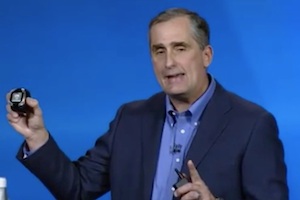
Time for Linux and kin.
“This is a consumer show, like it or not”, said Intel CEO Brian Krzanich, as he gave his maiden CES keynote talk last night. Judging by what he said (and didn’t say), the consumer electronics world is built on Linux and Android. His focus was on wearables.
“They don’t integrate all the features you want, you still had to have something else with you”, Krzanich said about smart watches and other wearables. “And you ’re not solving real problems, the problems people want solved at the time”.
Intel’s answer is adding more and more functionality – using audio ear buds to measure heart rate, for example – and putting more processing power into tiny devices. To jump start that effort, Krzanich announced a competition worth $1.3 million in prize money – $500,000 for first place – for new ideas. According to Intel’s press release…
The product must be based on Intel technology and be a sensor or computing device that is attached, embedded or worn on the body.
Krzanich bent over backwards to be operating system-agnostic. The convertible PC/tablet he demoed boots into either Android or Windows. The one actual Intel product he introduced – a Pentium-class system-on-a-chip called Edison, built into a standard, small SD card – runs Linux, not Windows. Intel’s re-launched security platform supports anything.
The reference designs in the spotlight last night did not include smart phones or pure tablets. Krzanich talked up productivity applications, in contrast to Steve Mollenkopf, Qualcomm’s CEO-in-waiting, who extolled media consumption earlier in the day. The two dominant chip makers staked out their turf yesterday, and there’s surprisingly little overlap in market positioning. The one thing Krzanich and Mollenkopf seem to agree on, though, is that the consumer electronics industry’s future lies with open source operating systems and their derivatives, not Windows.
